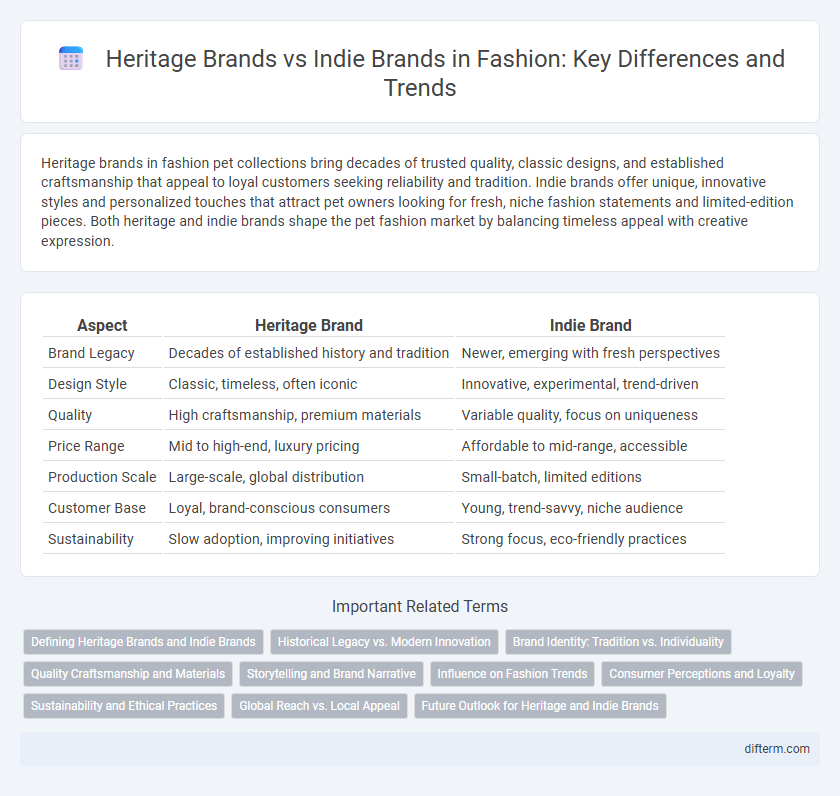Heritage brands in fashion pet collections bring decades of trusted quality, classic designs, and established craftsmanship that appeal to loyal customers seeking reliability and tradition. Indie brands offer unique, innovative styles and personalized touches that attract pet owners looking for fresh, niche fashion statements and limited-edition pieces. Both heritage and indie brands shape the pet fashion market by balancing timeless appeal with creative expression.
Table of Comparison
| Aspect | Heritage Brand | Indie Brand |
|---|---|---|
| Brand Legacy | Decades of established history and tradition | Newer, emerging with fresh perspectives |
| Design Style | Classic, timeless, often iconic | Innovative, experimental, trend-driven |
| Quality | High craftsmanship, premium materials | Variable quality, focus on uniqueness |
| Price Range | Mid to high-end, luxury pricing | Affordable to mid-range, accessible |
| Production Scale | Large-scale, global distribution | Small-batch, limited editions |
| Customer Base | Loyal, brand-conscious consumers | Young, trend-savvy, niche audience |
| Sustainability | Slow adoption, improving initiatives | Strong focus, eco-friendly practices |
Defining Heritage Brands and Indie Brands
Heritage brands in fashion are established companies with a rich history, often spanning decades or centuries, known for their timeless craftsmanship, legacy, and consistent quality. Indie brands, by contrast, are smaller, independent labels that emphasize unique, innovative designs and personal storytelling, frequently appealing to niche markets. Both heritage and indie brands contribute distinct value: heritage brands represent tradition and enduring reputation, while indie brands drive creativity and contemporary trends.
Historical Legacy vs. Modern Innovation
Heritage brands draw on a rich historical legacy, emphasizing timeless craftsmanship and established reputations dating back decades or even centuries. Indie brands prioritize modern innovation, leveraging cutting-edge design techniques and contemporary cultural trends to appeal to forward-thinking consumers. The balance between preserving tradition and embracing new ideas defines the dynamic landscape of today's fashion industry.
Brand Identity: Tradition vs. Individuality
Heritage brands emphasize a strong brand identity rooted in tradition, craftsmanship, and long-established values that convey reliability and timeless elegance to consumers. Indie brands prioritize individuality by showcasing unique designs, innovative concepts, and personal storytelling that appeal to niche markets seeking authenticity and distinctiveness. Both approaches shape consumer perception, with heritage brands leveraging history to build trust, while indie brands capitalize on originality to foster emotional connections.
Quality Craftsmanship and Materials
Heritage brands are renowned for their decades-long dedication to quality craftsmanship, often utilizing time-honored techniques passed down through generations to create durable, meticulously constructed garments. Indie brands, while newer, prioritize innovative materials and artisanal techniques, focusing on sustainable sourcing and unique, hand-finished details that set them apart in niche markets. Both types emphasize superior material selection, with heritage brands favoring classic, refined fabrics and indie brands experimenting with eco-friendly textiles and modern blends to appeal to discerning consumers.
Storytelling and Brand Narrative
Heritage brands leverage decades of history and craftsmanship to create rich, emotionally resonant storytelling that builds trust and loyalty among consumers. Indie brands often craft unique, authentic narratives reflecting innovation and cultural relevance, appealing to niche markets seeking distinct identity and values. Effective brand narratives, whether rooted in legacy or originality, drive consumer engagement by connecting products to meaningful stories and experiences.
Influence on Fashion Trends
Heritage brands shape fashion trends through decades of craftsmanship, iconic designs, and established cultural significance, setting standards that often inspire the industry's direction. Indie brands influence fashion trends by introducing innovative styles, niche aesthetics, and agile responses to consumer preferences, driving diversity and fresh creativity. The dynamic between heritage brands' timeless appeal and indie brands' experimental approaches fuels the evolution of contemporary fashion trends.
Consumer Perceptions and Loyalty
Heritage brands are often perceived as symbols of timeless quality and trust, fostering strong emotional connections that drive long-term consumer loyalty. Indie brands attract consumers seeking unique, authentic experiences and innovative designs, appealing to niche markets with distinctive storytelling. While heritage brands benefit from established reputations, indie brands leverage agility and personalization to engage younger, trend-conscious audiences.
Sustainability and Ethical Practices
Heritage brands often incorporate sustainability through established supply chains and long-term commitments to ethical craftsmanship, leveraging decades of expertise to minimize environmental impact. Indie brands prioritize transparency and innovation, frequently adopting cutting-edge sustainable materials and ethical labor practices to differentiate themselves in a competitive market. Both contribute to the fashion industry's shift towards sustainability, with heritage brands emphasizing legacy and quality while indie brands champion agility and social responsibility.
Global Reach vs. Local Appeal
Heritage brands leverage decades of global recognition, extensive distribution networks, and established brand equity to dominate international markets with consistent quality and timeless appeal. Indie brands emphasize localized storytelling, niche craftsmanship, and cultural authenticity, fostering strong connections within specific communities and driving grassroots loyalty. The interplay between global reach and local appeal shapes consumer preferences, with heritage brands excelling in scalability while indie brands thrive through unique, region-specific experiences.
Future Outlook for Heritage and Indie Brands
Heritage brands leverage their longstanding reputation and quality craftsmanship to adapt through sustainable innovations and digital transformation, securing loyalty from evolving consumer bases. Indie brands capitalize on agility and niche market appeal, driving growth through unique storytelling and direct-to-consumer strategies that resonate with millennials and Gen Z. Both heritage and indie brands are poised for growth by embracing eco-conscious practices and embracing technology such as AI-driven personalization and immersive virtual shopping experiences.
heritage brand vs indie brand Infographic

 difterm.com
difterm.com